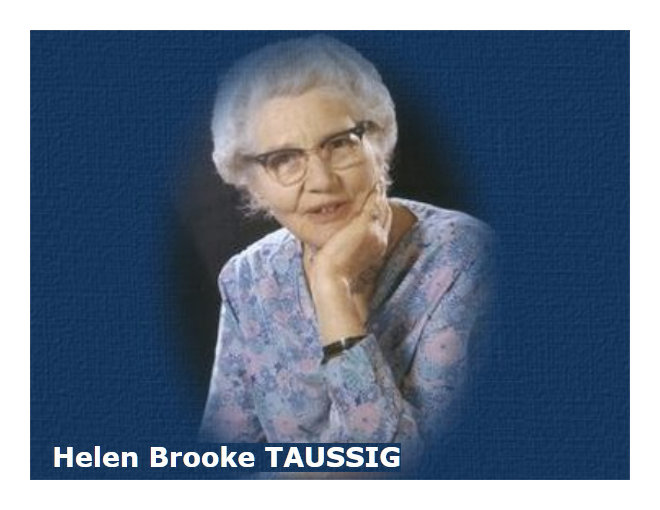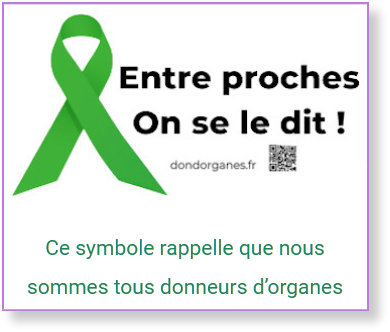Helen Brooke Taussig
Célébrités en cardiologie
(Celebrities in cardiology)

Helen Brooke Taussig . © Heart and Coeur ©
 Helen Brooke Taussig
Helen Brooke Taussig
Classifications et a descriptions de plusieurs malformations cardiaques
Helen Brooke Taussig a classifié et a décrit plusieurs malformations cardiaques.
Elle est connue pour avoir sauvé des vies "de bébés bleus".
Elle était la plus jeune de quatre enfants W. Taussig franc, un économiste bien connu qui enseignait à Harvard .
Sa mére, Edith, est morte quand Helen avait 11 ans.
Helen était une enfant frêle souffrant de la tuberculose qui l'a d'ailleurs souvent forcée à manquer beaucoup de jours à l'école.
À la consternation de son pére, les cartes du rapport de Helen n'étaient jamais bonnes. Cependant, en dépit de la lutte avec sa dyslexie, qu'elle a par la suite surmontée pour devenir une bonne lectrice, elle a réussie l'université de Radcliff, qui était en 1917 l'université des femmes, reliée à Harvard. Sa mére avait été une des premieres étudiantes à l'université de Radcliffe.
Taussig a alors gagné un BA à l'université Berkeley ( Californie ) en 1921. Elle a essayé d'entrer à Harvard mais l'université n'admettrait pas des femmes en ce temps.
Elle a alors pris des cours d'anatomie à l'université de Boston et a considérablement impressionné le professeur Alexander Begg, doyen et professeur d'anatomie, qui lui conseilla de s'inscrire à l'université de Johns Hopkins, Baltimore, dans le Maryland.
( une des rares écoles médicales en Américaine a accepter des femmes ).
C'est ce qu'elle fit avec l'aide d'une lettre de recommandation de Walter Bradford (1871-1945), et elle débuta chez Johns Hopkins en 1923, gagnant son M.d. en 1927.
Cependant, elle a été alors confrontée a la perte de son audition.
Déterminée à pratiquer de toute façon, son choix qui était la cardiologie pédiatrique, elle a appris à lire sur les lévres et aussi à "écoutez avec ses doigts" le coeur de ses patients.
Cette sensibilité acquise, combinée avec son sens aiguë d'observation, a mené Helen Taussig à un des découvertes les plus importantes dans les soins en cardiologie du vingtiéme siécle au commencement de la chirurgie à coeur ouvert.
Elle n'a pas réussi à obtenir un internat dans la médecine et la pédiatrie.
Le professeur Edwards A. Park, en ce temps, était en train de créer des cliniques spécialisé, et en 1930 elle a été nommée pour diriger sa clinique de cardiologie à Harriet Lane Home, une position qu'elle a tenue jusqu'en 1963.
Ici Helen s'intéressa à la fiévre rhumatismale et aux cardiopaties congènitales et commança à étudier les "bébés bleus". (enfants en bas âge dont la couleur bleue à la naissance indique un probléme en oxygénation de leur sang ).
Avec l'introduction des appareils plus avançés de radiographies aux rayons X, elle a commencé à noter quelques cas intéressants dans ces "bébés bleus".
Un jour, elle a noté quelque chose que personne n'avait avant jamais réalisée:
Comment se fait il , que quelques bébés bleus survivent plus longtemps que d'autres?
Tandis que quelques bleu-bébés mouraient aprés seulement quelques jours, d'autres vécurent pendant des mois et même des années.
Helen Taussig a su que tous les bébés survivaient avec des coeurs qui étaient légérement différents des adultes.
La différence la plus importante était un vaisseau sanguin trés spécial appelé Canal artériel
Taussig a su que ce vaisseau sanguin est normalement fermé aprés la naissance. Elle a également vu que la fermeture du canal arteriel était différent entre les personnes.
En utilisant son stéthoscope, elle pouvait faire la différence entre un coeur d'enfant et celui qui devenait adulte. Son étude l'a bientât menée à apprécier que la plupart des bébés cyanotiques ont un ventricule droit agrandi, et que la circulation compléte du sang aux poumons perturbée.
Sa conclusion était que si leCanal artériel Quand Alfred Blalock est venu à Johns Hopkins en 1941, Taussig lui a suggéré que la construction d'un Canal artériel pourrait fournir une solution aux problémese des enfants atteints de tétralogie de Fallot ou syndrome "de bébé bleu", ( syndrome causé par un défaut congénital de coeur qui prive le sang de la quantité nécessaire en oxygéne ).
Blalock et son brillant technicien Vivien Thomas, ont développé une idée pour qu'une opération aide des enfants qui ont cedéfaut congénital cyanotique, Blalock et Thomas, avancérent dans la problématique de fournir l'oxygéne à l'artére pulmonaire.
Un shunt essayé la premiére fois chez Vanderbilt a finalement fourni la réponse.
Aprés beaucoup de travail sur des animaux de laboratoire, le procédé de Blalock-Taussig ait été effectué avec succés sur un patient malade et à haut risque en 1944.
Il était profondément bleu et pouvait à peine manger car il haleter énormement.
Bien que l'enfant frêle soit mort des mois plus tard lors d'une deuxiéme opération, Cet enfant a survécu assez longtemps pour démontrer la survie d'un procédé chirurgical qui sauverait les vies des dizaines de milliers d'enfants.
"il est une belle couleur maintenant!"
Le succés de l'opération a apporté l'identification de Taussig en tant que fondateur de la cardiologie pédiatrique. En 1945, Helen Taussig et Alfred Blalockont édité un papier commun sur les trois premiéres opérations dans le journal de l'association médicale américaine;
Cette publication a eu un impact mondial immédiat.
Taussig et Blalock ont fait de nombreuses présentations et démonstrations cliniques de cas en l'Europe et aux Etats-Unis. Le succés du procédé a attiré beaucoup de patients à Johns Hopkins pour le traitement, et il a également apporté à beaucoup de médecins d' apprendre les techniques de cette procédure.
 Helen Brooke Taussig
Helen Brooke Taussig
Helen Brooke Taussig classified and described many of the cardiac malformations
Helen Brooke Taussig classified and described many of the cardiac malformations.
She is known for saving the lives of "blue babies", and played an important role in preventing the use of thalidomide in the USA. She was the youngest of four children Frank W. Taussig, a well known economist who taught at Harvard and was adviser to Woodrow Wilson. Her mother, Edith, née Guild, died when Helen was 11 years old. She was a frail child suffering from tuberculosis that often forced her to skip many days at school.
To make matters worse, she had dyslexia. To the dismay of her father, Helen's report cards were never good. However, despite struggling with her dyslexia, which she eventually overcame to become a good reader, she completed Radcliff College, the women's college connected to Harvard, in 1917. Her mother had been one of the first students at Radcliffe College. Taussig then gained a BA at the University of California, Berkeley, in 1921.
She attempted to enter Harvard but at this time the university would not admit women. She then took a course of anatomy at Boston University and greatly impressed professor Alexander Begg, dean and professor of anatomy, who advised her to apply to Johns Hopkins University, Baltimore, Maryland, one of very few medical Schools in America that accepted women.
This she did with a letter of support from Walter Bradford Cannon (1871-1945), and she commenced at Johns Hopkins in 1923, gaining her M.D. in 1927.
However, she was then confronted with the loss of her hearing. Determined to practice anyway, and choosing paediatric cardiology as her specialty, she learned to read lips and to "listen with her fingers" to her patients' hearts. This fine-tuned sensitivity, combined with her acute powers of observation, led Taussig to one of the most important discoveries in cardiac care in the twentieth century—and to the beginning of open-heart surgery.
She did not succeed in obtaining an internship in medicine and entered paediatrics. Professor Edwards A. Park, at the time, was initiating specialty clinics, and in 1930 she was appointed to head his cardiac clinic at the Harriet Lane Home, a position she held until 1963.
Blue babies Here she became interested in rheumatic fever and congenital heart defects and began studying "blue babies," infants whose colour at birth indicated inadequate oxygenation of their blood. With the introduction of more advanced x-ray machines, she started to notice some interesting patterns in her blue babies. One day, she noticed something that nobody had ever realized before. How could it be, wondered Helen, that some blue-babies lived longer than others? While some blue-babies died after only a few days, others lived for months and even years.
Helen Taussig knew that all babies were born with hearts that were slightly different from grown-ups. The most important difference was a very special blood vessel called the Ductus arteriosus. Ductus arteriosus A key arterial shunt (ductus) in fetal life. Before birth, blood pumped from the heart through the pulmonary artery toward the lungs is shunted into the aorta. This arterial shunt is a short vessel called the Ductus arteriosus. When the shunt is open, it is said to be patent.Taussig knew that this blood vessel normally closed by itself after birth. She also knew that the timing of when the ductus closed varied between people. By using her stethoscope, she could tell when a child's heart was making the change towards becoming adult-like.
Her studies soon led her to appreciate that most cyanotic heart babies had an enlarged right ventricle, and that complete circulation of the blood to the lungs was prevented.
She connected the downward march of cyanotic heart disease and death with anoxaemia and first recognised that patients with a patent ductus and cyanotic heart disease did far better than those without, and that closure of the ductus in such circumstances was followed by a worsening of the condition. She reasoned that if the ductus arteriosus could be kept open or if an artificial pathway could be constructed, the blue babies would get blood to the lungs and do much better.
When Alfred Blalock came to Johns Hopkins in 1941, Taussig suggested to him that the construction of a patent ductus might provide a solution to the anoxia of children with Fallot's tetralogy or "blue baby" syndrome, a syndrome caused by a congenital heart defect that deprives the blood of the necessary amount of oxygen.
With Blalock's brilliant technician, Vivien Thomas, they developed an idea for an operation to help children with cyanotic congenital heart defect, Blalock and Thomas, continued to move forward with the problem of providing oxygen to the pulmonary artery. A shunt first tried at Vanderbilt ultimately provided the answer. After much work on laboratory animals, the Blalock-Taussig procedure was successfully performed on a very ill, high-risk patient in 1944. He was deeply blue and could hardly eat without gasping for air. Although the frail child died months later in a second operation, the child survived long enough to demonstrate the survival of a surgical procedure that would save the lives of tens of thousands of children.
"He's a lovely colour now!"
The success of the operation brought Taussig recognition as the founder of paediatric cardiology.
In 1945, Helen Taussig and Alfred Blalock published a joint paper on the first three operations in the Journal of the American Medical Association; this publication had an immediate worldwide impact. Taussig and Blalock made numerous clinical presentations and case demonstrations in both Europe and the United States. The success of the procedure attracted many patients to Johns Hopkins for treatment, and it also brought many physicians to learn the techniques of the procedure.
Thank you to http://www.whonamedit.com/ for the sourcing



